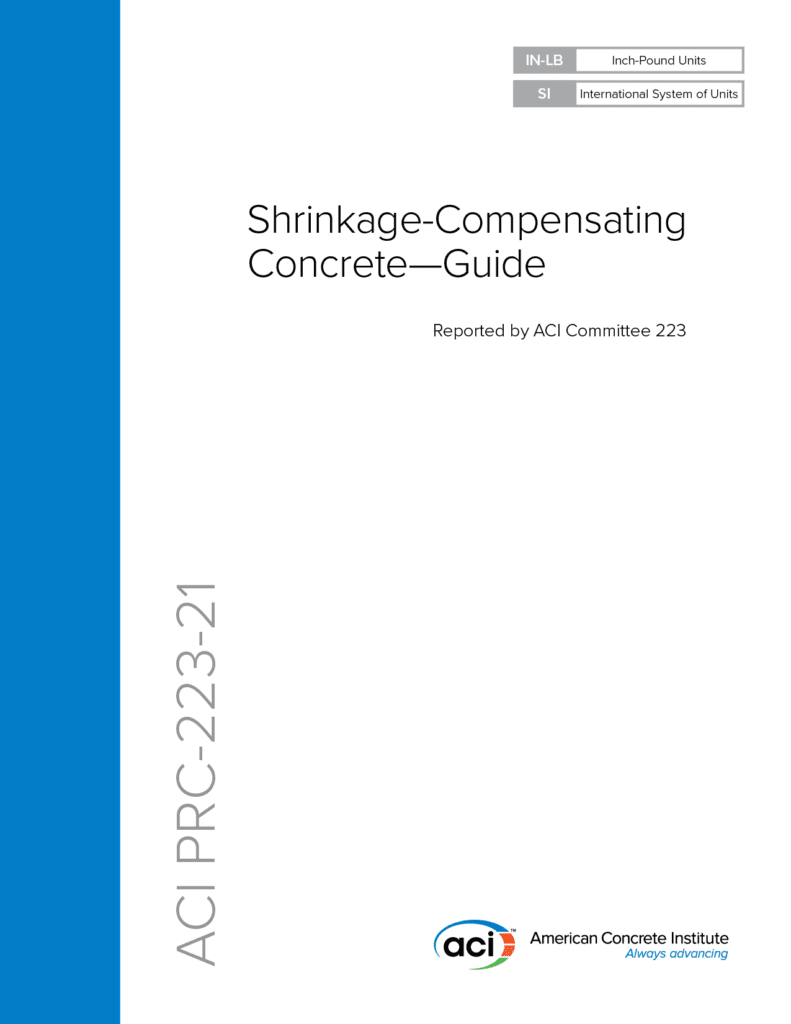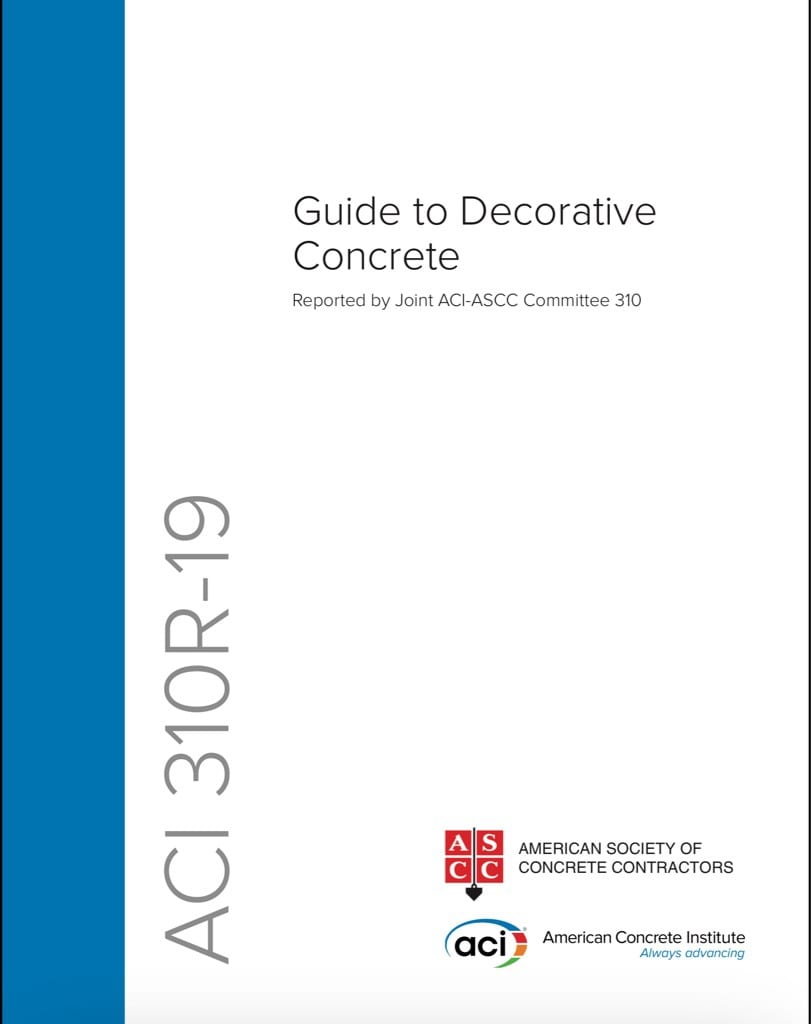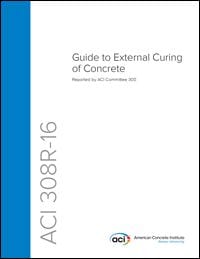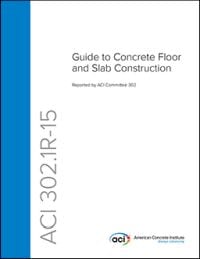Concrete Guides

ACI PRC-223-21 DESCRIPTION
Shrinkage-compensating concrete is used in construction to minimize drying-shrinkage cracking. Its characteristics are similar to those of portland cement concrete. The materials, proportions, placement, and curing should ensure that expansion compensates for subsequent drying shrinkage. This guide sets forth criteria and practices to ensure the development of expansive strain in concrete. In addition to discussing basic principles, methods and details cover structural design, concrete mixture proportioning, placement, finishing, and curing. The materials, processes, quality control measures, and inspections described in this document should be tested, monitored, or performed as applicable only by individuals holding the appropriate ACI certifications or equivalent.
ACI 310R-19 DESCRIPTION
This guide describes techniques for imparting aesthetic finishes to concrete flatwork, many of which can be combined for unique effects. The owner and architect/engineer will acquire detailed, practical guidance for achieving aesthetic effects using proven techniques. Recommendations are made for producing cast-in-place decorative concrete flatwork, decorative stains, and overlays. In addition to attention to the specified materials, mixture designs, concrete placement, curing, protection, sealing, and other treatments, this guide also considers the effects of these treatments on the overall aesthetics of the project.


ACI 306R-16 DESCRIPTION
This document guides specifiers, contractors, and concrete producers through the selection processes that identify methods for cold-weather concreting. The objectives of cold weather concreting practices are to A.) prevent damage to concrete due to freezing at early ages, B.) ensure that the concrete develops the recommended strength for safe removal of forms, C.) maintain curing conditions that foster normal strength development, D.) limit rapid temperature changes, and E.) provide protection consistent with intended serviceability of the structure. Concrete placed during cold weather will develop sufficient strength and durability to satisfy intended service requirements when properly proportioned, produced, placed, and protected.
ACI-308R-16 DESCRIPTION
This guide reviews and describes practices, procedures, materials, and monitoring methods for external concrete curing and provides guidance for specifying curing procedures. Current curing techniques are presented, and commonly accepted methods, procedures, and materials are described. Methods are given for curing structures, buildings, pavement, slabs-on-ground, and mass concrete. Curing methods for several specific categories of cement-based products are discussed in this document.


ACI 302.1R-15 DESCRIPTION
The quality of a concrete floor or slab depends on achieving a hard and durable surface that is flat, relatively free of cracks, and at the proper grade and elevation. The mixture proportions and the quality of the concreting and jointing operations determine the surface properties. The timing of concreting operations, especially finishing, jointing, and curing, is critical. Failure to address this issue can contribute to undesirable characteristics in the wearing surface, such as cracking, low resistance to wear, dusting, scaling, high or low spots, poor drainage, and increased curling.
Concrete floor slabs employing portland cement, regardless of slump, will experience a reduction in volume as soon as they are placed. This phenomenon will continue as long as water, heat, or both are released into the surroundings. Moreover, because the drying and cooling rates at the top and bottom of the slab are not the same, the shrinkage will vary throughout the depth, causing the as-cast shape to be distorted and reduced in volume.
This guide contains recommendations for controlling random cracking and edge curling caused by the concrete’s normal volume change. Application of present technology permits only a reduction in cracking and curling, not elimination. Even with the best floor designs and proper construction, it is unrealistic to expect completely crack- and curl-free floors. Consequently, every owner should be advised by both the designer and contractor that it is completely normal to expect some amount of cracking and curling on every project and that such an occurrence does not necessarily reflect adversely on either the adequacy of the floor’s design or the quality of its construction (Ytterberg 1987).
This guide describes how to produce high-quality concrete slabs on ground and suspended floors for various classes of service. It emphasizes such aspects of construction as site preparation, concrete materials, concrete mixture proportions, concrete workmanship, joint construction, load transfer across joints, form stripping procedures, finishing methods, and curing. Flatness/levelness requirements and measurements are outlined. A thorough preconstruction meeting is critical to facilitate communication among key participants and to establish expectations and procedures that will be employed during construction to achieve the floor qualities required by the project specifications. Adequate supervision and inspection are required for job operations, particularly those of finishing.
Flatwork Guide
The instructions and advice given here will help all parties involved in placement succeed in creating an exposed concrete floor that will look its best.
These guidelines will help ensure that both the owner’s and the architect’s expectations are met and, if specified, positively impact a profiled, honed, and polished finish. The flatwork contractor and PHP contractor should be included in the pre-construction and pre-pour meetings to discuss the procedures outlined below.

GET AN EDITABLE SPEC FOR YOUR PROJECT
Request a Project Spec Today! Or Call (844) 200-7336

